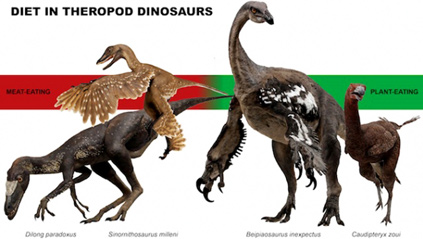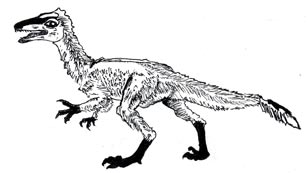New Study Shows Diversity in Coelurosaurs
The coelurosaurs were the most successful and diverse of the groups of dinosaurs that make up the theropods. Scientists had thought for many years that the majority of the animals that were classified as coelurosaurs were small, nimble predators with long arms, equipped with sharp-clawed, three-fingered, grasping hands.
Birds are now believed to be advanced members of the coelurosaur group. Although the phylogeny of Coelurosauria is far from resolved, tyrannosaurs are classifed as members of the Coelurosauria and as such the typical coelurosaur may be thought of as being entirely carnivorous. However, a new study into the known coelurosaur fossil material has revealed that a surprising number of families were not entirely meat-eaters, indeed, many were omnivores whilst others may have been entirely vegetarian.
Coelurosaurs
In a new review of all thing Coelurosauria, published in the scientific publication “The Journal Proceedings of the National Academy of Sciences”, it seems that members of the Coelurosauria adapted to a very wide ranging variety of diets. True, some were vicious predators, feeding entirely on meat, whilst others adopted a completely vegetarian habit.
The study was carried out by scientists attached to the Field Museum in Chicago (United States), ironically, the home of the perhaps the best known extinct Coelurosaur fossil of all – the giant T. rex known as “Sue”. One of the authors, Lindsay Zanno stated:
“Anything that belongs in that group that seems to be an exclusive meat-eater, things like Velociraptor of Jurassic Park fame, it means it probably evolved from an ancestor that had already begun eating some plants.”
Classifying the Theropoda
The problem with the classification of Theropoda can be traced back to the 19th century when Victorian scientists first began to classify dinosaurs. Their early work led to the establishment of two, great groups of bipedal, lizard-hipped dinosaurs. Firstly, there was the Carnosaurs – large bodied, bipeds with large skulls, a group that included the likes of Allosaurus and Megalosaurus. It was the German scientist and palaeontologist Friedrich von Huene who first coined the phrase Coelurosauria (1914), the “hollow tailed lizards”, consisting of small, gracile, bipedal theropods. It was Huene himself, who first postulated that the tyrannosaurs may be coelurosaurs and not carnosaurs, contradicting his classification of these two main groups of theropod dinosaurs. This was the start of the intense debate over theropod phylogeny.
The Diversity of Diets within Coelurosauria

Picture credit: Lindsay Zanno
Adding to the data, is this new study by Lindsay Zanno and her Field Museum colleague Peter Makovicky. If one considers extant birds, they all have toothless beaks, but they eat a great variety of different foods, from garden worms, insects, to berries, nectar and carrion. Zanno and Makovicky set out to review the fossil coelurosaur material to see if they could establish a clearer idea of just what each main type of coelurosaur may have eaten.
The researchers identified 72 coelurosaur species that had been found with direct fossil evidence of what they ate, including fossilised stomach contents and coprolites. The American based scientists then statistically analysed the anatomy of these dinosaurs looking for physical traits that correlated with plant-eating.
Coelurosaur Species
Physical characteristics such as a longer neck, leaf-shaped or peg-like teeth and the presence of a horny beak were identified in 44 of the species studied, across six subgroups. Their assessments indicate that these members of the coelurosaur family were at least partly vegetarian.
Commenting on the findings, Lindsay Zanno said:
“It appears as if the transition from carnivory, or meat-eating, to plant-eating occurred very early in the evolutionary history of the group and probably occurred once.”
The research suggests that Late Cretaceous carnivores such as Tyrannosaurus rex and Velociraptor likely evolved back to meat-only diets after their ancestors spent at least some time chewing on plants.
Commenting on the study, Thomas Holtz, a vertebrate palaeontologist at the University of Maryland stated:
“Wer’re not seeing special cases of herbivory evolving from carnivorous ancestors. We are seeing one origin of the herbivory here.”
The study raises new questions about the environmental niches inhabited by coelurosaurs, such as whether switching to plant-based diets restricted their range. The research is also helpful in the context of understanding the evolutionary of Aves. Although beaks evolved independently many times throughout history, the new study suggests that a plant- based diet was the push the coelurosaurs needed to turn toothy mouths into toothless beaks.
An Example of a Coelurosaur (Theropod Dinosaur)
Picture credit: Everything Dinosaur
Zanno commented:
“Once you have a beak, you can adapt it into all different shapes and sizes, and you can adapt it to do all different kinds of things.”
To view models and replicas of coelurosaurs: Safari Ltd. Prehistoric World Figures.







Leave A Comment